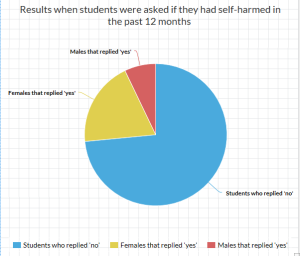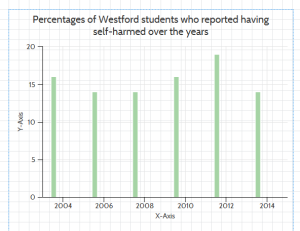Lauren Cullen
Editor-in-Chief
As mentioned before in our feature on senior Aryn Tedstone, the 2014 Youth Risk Behavior Survey by Emerson Hospital reported that 14% of the 7,026 students polled reported that they had self harmed before.
The graph above shows that in the past 10 years, the YRBS has shown very similar numbers when Westford students were asked if they had self-harmed.
“Self harm is a very unique issue,” said Guidance Counselor Tracy McLaughlin. “I think for us at WA we’ve had years where there has been a decline and years where there has been an increase, but there is no way to sort of gauge it. It’s a matter of student population from year to year.”
McLaughlin said she believes that while school stress can be a factor in self-harming, she does not believe that it is the cause of self-harm.
“The issue to look at is that this is a coping mechanism that the individual uses to target stress in general, that’s what we want to target. While stress will increase that behavior, the behavior itself came about as a way to cope with stress, that we of course want to change,” said McLaughlin.
Overall, she said that the guidance department is concerned about finding the origin of self-harm and to work with the student on it.
Another statistic that stood out was the extreme difference in percentages of local females that self-harm compared to the percentage of males that self harm.
 The graph above shows that almost triple the amount of males that self-harm (7.1%) is equal to the amount of females that self-harm (19.4%). McLaughlin said that the Guidance department is aware of statistics like these, and are looking at other studies similar to this one to try to pinpoint exactly why the numbers are so drastically different.
The graph above shows that almost triple the amount of males that self-harm (7.1%) is equal to the amount of females that self-harm (19.4%). McLaughlin said that the Guidance department is aware of statistics like these, and are looking at other studies similar to this one to try to pinpoint exactly why the numbers are so drastically different.
“When we find out, we work with students individually to talk about how they can help handle stress,” she said. “And we refer them to outside counseling because it is important for them to find and identify ways to reduce the stress without harming themselves. Teaching them new coping skills is the key.”












